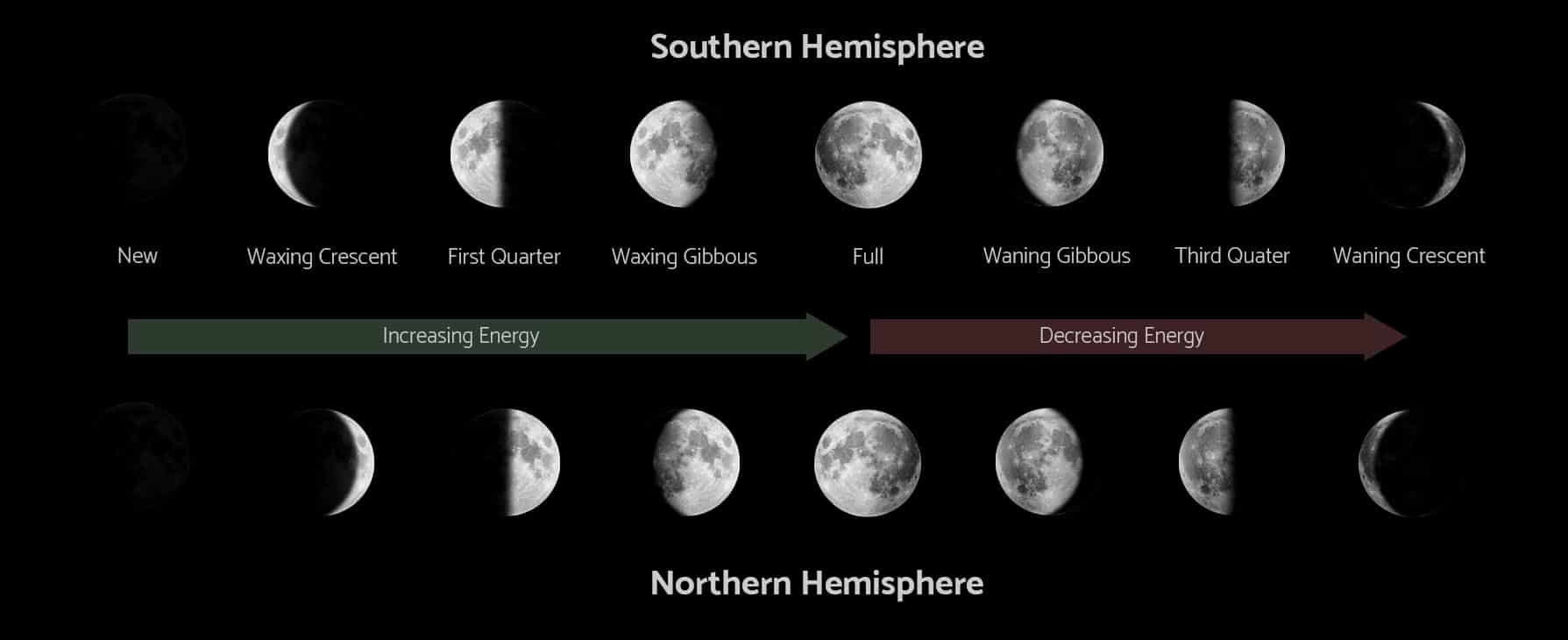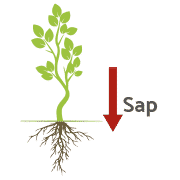Planting guide
Moon cycles
Moon planting guide
Planting by the cycles of the moon has been followed for centuries and many believe there is a definite influence on the health and viability of plants.There is a lot of skepticism among scientists about the validity of plant growth and health being affected by the moon.
One possible explanation is that the effect the gravitatiional pull of the moon has on water may control the movement of sap within the plants. New and full moon pulls tides (highest at these times) and also pulls on water in the earth causing moisture to rise towards the surface which encourages growth. When the moon is waxing i.e. heading towards a full moon, the sap is drawn up by the plant. Inversely, when the moon is waning, the sap is drawn down focusing the energy to the roots of the plants.
There is also some suggestion that moonlight and the Earth's electromagnetic field also influence plant growth.
It is possible to buy lunar calendars that track move phases day-by-day for an entire year.
One possible explanation is that the effect the gravitatiional pull of the moon has on water may control the movement of sap within the plants. New and full moon pulls tides (highest at these times) and also pulls on water in the earth causing moisture to rise towards the surface which encourages growth. When the moon is waxing i.e. heading towards a full moon, the sap is drawn up by the plant. Inversely, when the moon is waning, the sap is drawn down focusing the energy to the roots of the plants.
There is also some suggestion that moonlight and the Earth's electromagnetic field also influence plant growth.
It is possible to buy lunar calendars that track move phases day-by-day for an entire year.




New Moon
What happens in this phase? (4 days)
The moon is aligned between the earth and the sun. The sun lights up the far side of the moon and we can't see any reflection.
The new moon phase gradually starts, and vitality is at its lowest. Gravity pulls tides and also pulls water up in the earth causing moisture to rise towards the surface.
Seeds absorb water- giving better germination and a healthier start
Root and leaf growth is good.
The new moon phase gradually starts, and vitality is at its lowest. Gravity pulls tides and also pulls water up in the earth causing moisture to rise towards the surface.
Seeds absorb water- giving better germination and a healthier start
Root and leaf growth is good.
What to do in the garden
This is a good time to prepare soil for the next high growth period coming ahead:
- Apply liquid fertilisers
- Plant vegetables that produce crops above ground but do not have seeds within fruit e.g. broccoli, cabbage
- Plant crops that we eat the leaves or stems eg. lettuce, celery, spinach
- Plant flowering annuals, grains and sow annual grasses
- Prune
When to avoid?
12 hours before and after the new moon.
This is when the plants have the lowest energy.
This is when the plants have the lowest energy.


Waxing Moon
What happens in this phase? (10 days)
In this phase moonlight gradually increases and with it the longest prolific period for all above ground crops starts. Energy starts increasing and sap in plants keeps flowing up, which also increases leaf growth.
The gravitational pull of the moon is less but the moonlight is stronger and increasing up to the full moon.
Sap flow is increasing which promotes stem and leaf growth.
Optimum time to plant is two days before the full moon
The gravitational pull of the moon is less but the moonlight is stronger and increasing up to the full moon.
Sap flow is increasing which promotes stem and leaf growth.
Optimum time to plant is two days before the full moon
What to do in the garden.
Time to really get going!
- Plant short lived plants that we harvest the leaves, seeds, flowers or fruits
- Foliar fertilise
- Tip-prune shrubs
- Best time for sowing and transplanting flowering annuals (marigolds, nasturtiums), biennials, grains, grasses, green manure crops and melons
- Apply liquid fertilisers (taken up quickly)
- Prune (new growth will be produced quickly)
- Graft (increased sap flow leads to new growth more quickly
- Plant seeds as this is when moisture is close to the surface.
When to avoid?
- Twelve hours before the full moon



Full moon
What happens in this phase? (4 days)
The moon is at its maximum light with Earth between the sun and the moon. We see the full half of the moon lit by the sun.
The full moon also pulls tides (highest at these times) and also pulls on water in the earth causing moisture to rise towards the surface encouraging growth.
Twelve hours after the full moon all living things, including plants, are at the peak of energy levels.
There is more moisture in soil but moonlight starts to decrease after full moon along with energy decreasing as the moon wanes
The full moon also pulls tides (highest at these times) and also pulls on water in the earth causing moisture to rise towards the surface encouraging growth.
Twelve hours after the full moon all living things, including plants, are at the peak of energy levels.
There is more moisture in soil but moonlight starts to decrease after full moon along with energy decreasing as the moon wanes
What to do in the garden.
As this phase is very short and energy very high, it is ideal for sowing plants that require quick germination and quick growth in a short period of time like edible sprouts and microgreens.
Seeds absorb the most water at this time.
Sap starts to flow down directing energy to the roots.
- Plant or sow root crops (beetroots, carrots, onions, potatoes)
Plant fruiting perennials (apples etc.), shrubs, vines, also asparagus, rhubarb, strawberries, perennial berbs , lawn grasses and biennials as well as bulbs
- Take cuttings, divide plants and transplant plant as it's a good time for root growth
- Prune dormant plants
- Harvest
Seeds absorb the most water at this time.
Sap starts to flow down directing energy to the roots.
- Plant or sow root crops (beetroots, carrots, onions, potatoes)
Plant fruiting perennials (apples etc.), shrubs, vines, also asparagus, rhubarb, strawberries, perennial berbs , lawn grasses and biennials as well as bulbs
- Take cuttings, divide plants and transplant plant as it's a good time for root growth
- Prune dormant plants
- Harvest
When to avoid?
- 12 hours before and after the full moon


Waning moon
What happens in this phase? (9 days)
Moonlight and gravitational pull decreases. Energy starts decreasing so most of this period (except the two days at each end of the phase) is considered as a dormant or resting time.
What to do in the garden.
Although it's a resting period for the garden, it's one of the most active periods for gardeners. This is the time to improve the soil. Germination is lower and regrowth slower at this time.
- Avoid planting above ground crops
- Add microbial solution to soil
- Add fertiliser to soil
- Harvest produce for longest shelf life - harvested crops are less likely to rot as sap flow is lower in the foliage of plants
- Take cuttings and divide plants
- Improve soil - weed, mulch, make compost and manure teas.
- Cut back vigorous growing shrubs and vines as regrowth will be less
- Root crops and bulbs can still be planted as sap flow is drawn down to the roots encouraging root, tuber an bulb growth
Considerations
If adhering to the lunar cycle, try to avoid doing anything other than watering 12 hours either side of each phase.
Being aware of the lunar cycle was something we would take into consideration but didn’t always follow strictly. It is another tool, and no single factor determines success. In a commercial set up it is very hard to follow these phases as we had to keep up production constantly and couldn’t afford waiting periods for “the right time”.
On a small scale it may be possible to follow the moon phases and anything that helps to improve the health and vitality of plants is worth the effort particularly when it's working with nature and not against it.
If we had seedlings that needed to be planted, we planted them to prevent them becoming stressed and ‘leggy’. Similarly, if we had just prepped a garden bed, we would add soil solutions at that point (regardless of what stage in the lunar cycle it happened to be) and supplement with compost and fertilisers when they were required.
However, I should say, that sometimes these seedlings would take off soon after planting but at other times they seemed to stay stagnant waiting for conditions to be just right (moon cycle?) We did notice that there were times when growth seemed to be erratic or seeds would take longer to germinate and we’d realise that it was a new or full moon.
One way to remember the phases of the moon is to use the three letters, DOC which indicates how much of the moon we can see either side of the full moon.
Being aware of the lunar cycle was something we would take into consideration but didn’t always follow strictly. It is another tool, and no single factor determines success. In a commercial set up it is very hard to follow these phases as we had to keep up production constantly and couldn’t afford waiting periods for “the right time”.
On a small scale it may be possible to follow the moon phases and anything that helps to improve the health and vitality of plants is worth the effort particularly when it's working with nature and not against it.
If we had seedlings that needed to be planted, we planted them to prevent them becoming stressed and ‘leggy’. Similarly, if we had just prepped a garden bed, we would add soil solutions at that point (regardless of what stage in the lunar cycle it happened to be) and supplement with compost and fertilisers when they were required.
However, I should say, that sometimes these seedlings would take off soon after planting but at other times they seemed to stay stagnant waiting for conditions to be just right (moon cycle?) We did notice that there were times when growth seemed to be erratic or seeds would take longer to germinate and we’d realise that it was a new or full moon.
One way to remember the phases of the moon is to use the three letters, DOC which indicates how much of the moon we can see either side of the full moon.
Northern hemisphere:
Using D O C formation
A half moon - shape D - is waxing
Full moon – O
Crescent moon - shape C – is waning
Using D O C formation
A half moon - shape D - is waxing
Full moon – O
Crescent moon - shape C – is waning
Southern hemisphere:
Using C O D
A crescent moon - shape C - is waxing
Full moon - O
A half moon - shape D - is waning
Using C O D
A crescent moon - shape C - is waxing
Full moon - O
A half moon - shape D - is waning

